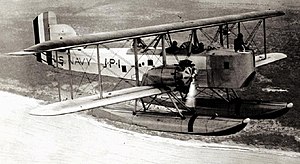Douglas T2D
| T2D | |
|---|---|

| |
| Douglas T2D-1 of VP-1 | |
| Role | Torpedo bomber |
| Manufacturer | Douglas Aircraft Company |
| First flight | 27 January 1927 |
| Introduction | 1927 |
| Retired | 1937 |
| Primary user | United States Navy |
| Number built | 31 |
The Douglas T2D was an American twin-engined torpedo bomber contracted by the military, and required to be usable on wheels or floats, and operating from aircraft carriers. It was the first twin-engined aircraft to be operated from an aircraft carrier.[1]
Development and design
In 1925, the United States Navy's Bureau of Aeronautics designed a twin-engined torpedo bomber aircraft, intended to have greater performance than contemporary single-engined aircraft.[1] A single prototype was built by the Naval Aircraft Factory as the XTN-1, which was quickly followed by three identical aircraft built by Douglas, the T2D-1.
The XTN/T2D was a large two bay biplane, capable of easy conversion between floats and wheels, and carrying a crew of four.
Operational history
The first three T2D-1's were delivered to the torpedo bomber squadron VT-2 on 25 May 1927,[1] being used for successful trials aboard the aircraft carrier Langley. A further nine T2D-1's were ordered in 1927, these normally being operated as floatplanes, partly owing to criticism from the Army of the Navy operating large land-based bombers,[1] and partly as its large size prevented Langley from embarking a full airwing.[2]
A further 18 aircraft were ordered in June 1930 as patrol floatplanes, being designated P2D-1. These were operated by Patrol Squadron VP-3 in the Panama Canal Zone until they were replaced by Consolidated PBYs in 1937.[1]
Variants

- XTN-1
- Original prototype built by Naval Aircraft Factory. One built.
- T2D-1
- Production aircraft, convertible torpedo bomber/patrol floatplane, powered by Wright R-1750 Cyclone. 12 built.
- P2D-1
- Dedicated patrol floatplane. Fitted with twin tail for improved engine out performance and powered by two R-1820 Cyclones. 18 built.
Operators
Specifications (T2D)
Data from The Encyclopedia of World Aircraft [2]
General characteristics
- Crew: four
Performance
Armament
- 2 × .30 in (7.62 mm) M1919 Browning machine guns
- 1 ×1,618 lb (734 kg) torpedo or equivalent bombload
References
- ^ a b Donald, David, The Encyclopedia of World Aircraft (pg 118). (1997). Prospero Books. ISBN 1-85605-375-X
